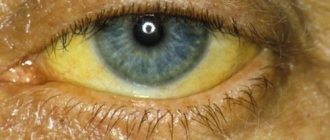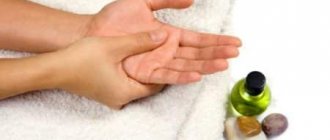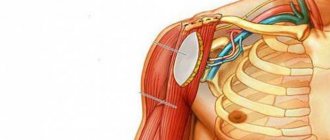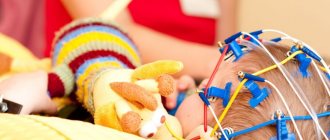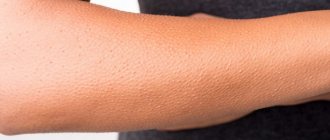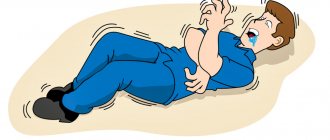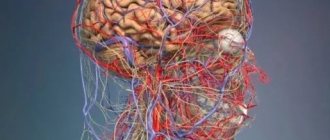Involuntary contraction of the muscle tissue of the upper limbs causes trembling of the hands. Physiological effects are associated with external load on muscle tissue, and tremor is a manifestation of severe emotional shock. If changing your lifestyle, avoiding stressful situations, does not eliminate trembling in the upper extremities, and the tremor continues, then you need to consult a doctor who will help determine why your hand shakes when stressed.
Impacts that cause hand tremors
Hand strain is caused in two main cases: physiological effects and abnormal changes that occur in the body as a result of the development of diseases.
Physiological factors, such as heavy loads on muscle tissue, strong emotional shocks that upset the normal function of the central nervous system, provoke tremor of the upper extremities.
When changing activities, followed by rest, when the psychological state changes, a natural restoration of nervous processes occurs, and the trembling in the hands goes away. There is a familial type of tremors in the hands, which is typical for children during puberty, and occurs when the situation in the family circle is unstable, the loads associated with study, sports, work, and stressful conditions increase.
Abnormal changes characterize tremor over a long period of time with increasing frequency and strength of trembling. The hand shakes when tense - this is a symptom that indicates the development of a serious painful condition.
Common causes of twitching
These are phenomena that often occur in everyday life:
- emotions that are “off the charts” - quarrels, conflicts, suppressed discontent, hidden anger, anxiety, fears, melancholy, irritability, vain expectations, much more that human life is full of;
- physical overload, especially among unprepared people - country weekends, running for transport, climbing stairs to the upper floors, carrying heavy objects;
- hypothermia or overheating – there is an intensive consumption of electrolytes, especially potassium and magnesium, which causes twitching;
- drinking large quantities of alcohol, which disrupts all types of metabolism, including mineral and water;
- drinking energy drinks with a high caffeine content, which excessively irritates the nervous system;
- lack of protein when following strict diets or an unbalanced diet, when calories are “gained” from carbohydrates;
- insufficient water consumption.
The daily need for water is 30 ml per kilogram of body weight in cool weather and 50 ml per kilogram in hot weather.
Such causes often occur in healthy people and do not require treatment.
All you need to do is eliminate the factor that caused the twitching. You need rest, normal sleep, nutrition balanced in essential substances, and enough water. It is best to discuss emotional problems with your doctor. This is especially true for long-term traumatic problems - situations in the family or work team, when a person, due to objective circumstances, cannot leave the conflict zone.
The best help in such situations is a psychotherapist who explains to the patient the true state of affairs and helps to cope with what cannot be corrected.
Typical division of hand tremors
Tremors that occur in the upper extremities are divided into types, which helps clarify the diagnostic picture:
- Cerebellar type - slow fluctuation of hand movements, deterioration in the direction of movement, accompanied by deterioration in speech, changes in walking, trembling in other parts of the body, such symptoms are associated with pathology of the cerebellum of the brain;
- Dystonic type - movement disorders associated with unnatural repetition of movements, which are accompanied by pain. It is a consequence of cerebral dystonia;
- The essential type is a slowly progressive symptom with characteristic swaying of the limbs, which interferes with normal life activities. Appears during stress, high body temperature, changes in blood sugar levels;
- Parkinsonian type is trembling during inactive physical activity caused by damage to brain structures;
- Peripheral type - tremor that occurs due to damage to the peripheral nervous system as a result of systemic diseases of the skeletal and muscular systems, injury to the limbs;
- Postural type - trembling of the limb when trying to hold the hand in a certain position;
- The psychogenic type is caused by psychopathological conditions.
Alternating Benedict's syndrome
Benedict's syndrome belongs to a group of alternating syndromes that affect the structures of the brain stem. Similar syndromes include Wallenberg syndrome, which affects the posterior inferior cerebellar artery, medial Dejerine syndrome, ventrocaudal pontine syndrome, or Foville syndrome. All these diseases are due to ischemia, thrombosis of the cerebral arteries, or hemorrhage, and are very difficult, since bilateral (and even extensive unilateral damage to the bridge) is incompatible with life.
An example is apoplexy (hemorrhage) in the pons. Its cause is a rapidly expanding hematoma, which can break into the cavity of the fourth ventricle. In this case, a violent onset occurs, with paralysis of the arms and legs, or even complete paralysis of the arms and legs, progressive respiratory disorders are added, blood pressure rises and malignant hyperthermia develops. Typically, with this type of brainstem stroke, death occurs within 24 hours.
With Benedict's syndrome, despite the proximity of the stem structures, the outcome is more favorable for life. Otherwise, Benedict's syndrome is called “red core” syndrome. It must be said that the red nucleus (nucleus ruber) is one of the extrapyramidal centers, more ancient than voluntary and conscious movements. This structure, together with the substantia nigra, “manages” many unconscious movements.
Therefore, when an acute disturbance of cerebral circulation occurs in the interpeduncular (or interpeduncular) deep branches of the posterior cerebral artery on one or both sides at once, the following characteristic symptoms arise:
- on the affected side, paralysis of the oculomotor nerve occurs, which is combined with constant dilation of the pupil (since signals to the sphincter of the pupil from the oculomotor nerve are interrupted in this ischemic focus);
Oculomotor nerve
- on the opposite half of the torso and limbs there is a decrease in almost all types of sensitivity: tactile (touch), vibration, discriminative (sense of difference between two closely located objects), sense of the position of the limbs in space, or joint-muscular sense;
- finally, a symptom of damage to the red nucleus is contralateral hyperkinesis. This means that hyperkinesis may occur on the opposite (healthy side).
Tremor as a symptom
If the physiological reasons that contribute to the occurrence of involuntary contraction of the arm muscles are quite objective and do not require heavy drug therapy, then hand tremors that appear during pathological changes caused by diseases require serious treatment.
Trembling of the upper extremities caused by external factors:
- Taking certain medications that provoke a rare and subtle involuntary contraction of the muscle tissue of the phalanges of the fingers;
- The accumulation of toxic substances released by honey preparations also contributes to trembling in the hands;
- Poisonings that cause intoxication that interferes with the normal movement of the limbs;
- Poor nutrition or insufficiency;
- Consequences of traumatic and mental conditions;
- The use of drugs and alcohol negatively affects the functioning of the muscles of the upper limbs;
- Hand tremors after head and neck trauma;
- Labor activity associated with increased load on the arm muscles;
- Stressful situations that impair the coordination of movement of the upper limbs.
Diseases that cause unnatural tension in the muscle tissue in the arms:
- Diseases associated with endocrine disorders, in most cases this is a larger volume of hormones produced by the thyroid gland. Then the trembling occurs in combination with a sharp change in weight, nervous disorders, and a change in heart rate. Systemic changes occur in the body;
- Diabetes - low blood sugar can cause tremors in the hands;
- Parkinsonism - muscle contraction occurs at rest, tension of muscle tissue during movement reduces the frequency and level of trembling. In this case, one limb trembles more than the other;
- Hypertension - increased blood pressure negatively affects brain activity and the body's blood supply system, which leads to a tremor;
- Injury or pathology of the cerebellum of the brain, which causes loss of partial control of movements, provokes low muscle tone;
- Disease of the vascular system;
- Multiple sclerosis;
- Hepatocerebral dystrophy with a decrease in copper metabolism in the body;
- Glycoglycemia;
- Stroke;
- Kidney diseases;
- Oncological diseases;
- Genetic abnormalities.
conclusions
Thus, chills are a condition characterized by trembling involving several muscle groups. A person begins to shake for many reasons. One of them may be associated with increased blood pressure, which is accompanied by vasoconstriction.
The most common reason why a person develops chills is an incipient cold or an infectious disease.
Such patients need consultation with specialized specialists (this could be a cardiologist or endocrinologist) and the prescription of adequate drug therapy.
source
Diagnostics
At the doctor’s appointment, an anamnesis of the symptomatic picture is compiled, on the basis of which the patient is sent for examination:
- Electromyography is a study of the bioelectrical activity of muscle tissue;
- Tremography - recording of a three-dimensional image of the tremor process;
- MRI - to assess the condition of the brain;
- Prescribing research to identify the causes and diseases that cause hand tremors, in the form of medical tests, blood tests, measuring blood pressure, consulting an ophthalmologist.
Treatment is medicinal
Therapeutic treatment is prescribed based on the source of tremor:
- To treat stress and depression, sedatives and sedatives are prescribed;
- In the treatment of tremor in the upper extremities, beta-alrenobolic agents are used to reduce the degree, frequency and strength of tremors;
- Injections with drugs based on botulinum toxin-A help reduce tremor;
- Honey anticonvulsant drugs.
Neurosurgical intervention occurs when taking medications does not produce the expected effect or hand tremors greatly reduce simple life processes. But stereotactic thalamotomy can cause deterioration in speech function, swallowing, and disability.
Signs of a hypertensive crisis
If you are shaking violently, shivering with high blood pressure, or a fever has set in, the cause may be the development of a hypertensive crisis. This is a complication of arterial hypertension that can lead to damage to internal organs, the brain, coma, and death. This condition requires emergency medical care.
Signs of a hypertensive crisis:
- migraine;
- chest pain;
- chills;
- tremor, numbness of extremities;
- nausea, vomiting;
- tachycardia;
- blurred vision, blurred vision;
- swelling of the body;
- pressure above 140/90 mm Hg. Art.;
- tinnitus;
- cold, clammy sweat;
- panic attacks, fear of death;
- facial redness.
Violent shaking occurs in stage 2 and 3 hypertension; in such patients a complicated crisis is diagnosed. Blood circulation is impaired, which can lead to cerebral encephalopathy, poor concentration, and decreased intellectual abilities. In addition, there is a high risk of stroke, heart attack, pulmonary edema, heart and kidney failure. Complications may be irreversible and persist after blood pressure has stabilized.
Therapeutic diet
Drawing up a proper nutrition plan has a beneficial effect on a person’s entire life activity.
A balanced diet includes:
- Meat products containing creatine to increase muscle mass;
- Chicken eggs and other products containing lecithin, vitamin D, which normalizes the activity of the nervous system;
- Boiled chicken and mackerel meat, buckwheat, almonds to restore muscle tissue;
- Fruits and juices for a complete enrichment of muscle tissue proteins;
- Dairy and fermented milk products reduce the sensation of muscle pain;
- Orange fruits and vegetables help relieve nervous tension.
In some cases, the method of complete therapeutic fasting is used, during which the patient is in a medical institution. Fasting helps to renew cellular structure, improve metabolic processes, cleanse the body, and reduce spasms in tissues and muscles.
Traditional methods
Home treatment must be agreed upon or prescribed by the attending physician. Therapy includes:
- Contrast water procedures that strengthen local immunity and improve blood circulation;
- Chewing tansy flowers;
- Decoction of herbs mint, lemon balm, motherwort, linden, peony;
- Tincture of Tibetan lofanta flowers;
- Oat decoction;
- Taking baths with sage;
- Massage with aromatic oils.
Other Tremor Treatments
Depending on the severity of hand tremors and the patient's general condition, the doctor may suggest other types of therapy:
- Treatment with leeches;
- Treatment with bee stings;
- Breathing exercises;
- Hydrotherapy.
Treatment of the symptom when the hand shakes under tension is a long and complex process, focused on treating the nature of its manifestation and suppressing the causes that caused it.
Avoiding the appearance of tremor is promoted by: a healthy lifestyle, adequate physical activity, and proper rest.
If symptoms appear, even if they are temporary and of little concern, you should consult a doctor for advice, undergo an examination if necessary, and begin treatment.
Author of the article: Neurologist Konstantin Olegovich Makheev.
